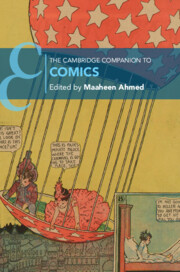Book contents
- The Cambridge Companion to Comics
- The Cambridge Companion to Comics
- Copyright page
- Contents
- Figures
- Contributors
- Acknowledgments
- Chronology
- Introduction
- Part I Forms
- Chapter 1 Comics Drawing
- Chapter 2 Comics, Media Culture, and Seriality
- Chapter 3 Comics and Graphic Novels
- Chapter 4 Manga
- Chapter 5 Digital Comics
- Part II Readings
- Part III Uses
- Further Reading
- Index
- Cambridge Companions To …
- References
Chapter 2 - Comics, Media Culture, and Seriality
from Part I - Forms
Published online by Cambridge University Press: 17 August 2023
- The Cambridge Companion to Comics
- The Cambridge Companion to Comics
- Copyright page
- Contents
- Figures
- Contributors
- Acknowledgments
- Chronology
- Introduction
- Part I Forms
- Chapter 1 Comics Drawing
- Chapter 2 Comics, Media Culture, and Seriality
- Chapter 3 Comics and Graphic Novels
- Chapter 4 Manga
- Chapter 5 Digital Comics
- Part II Readings
- Part III Uses
- Further Reading
- Index
- Cambridge Companions To …
- References
Summary
The aesthetics of comics is deeply linked to the history of media serialities. Modern comics were born in the newspaper and followed its periodic rhythms and exploited its logic of reader loyalty. The two historically dominant models of comics, the comic strip and the comic book, are each linked to a publication medium or format – the newspaper and the magazine, respectively – and to their logics of consumption. Many characteristics of the comic strip – the principle of gag variations, the importance of generic conventions, recurring characters, spin-off series, crossover logics – can be reinterpreted according to the industrial and media contexts in which they appear and which are aesthetically exploited by the authors. Reflection on the seriality of comics can therefore not be limited to analyses of plots or modes of graphic narration. It needs to consider media logics, including the industrial and commercial dynamics and modes of consumption they encourage. Ultimately, comics seriality engages with, on the one hand, the principles of generic seriality, which thematize these logics of production and consumption. On the other, diegetic seriality, of the recurrent character and the fictional universe, also determines the strategic choices of industrial and media players.
Keywords
- Type
- Chapter
- Information
- The Cambridge Companion to Comics , pp. 46 - 62Publisher: Cambridge University PressPrint publication year: 2023

